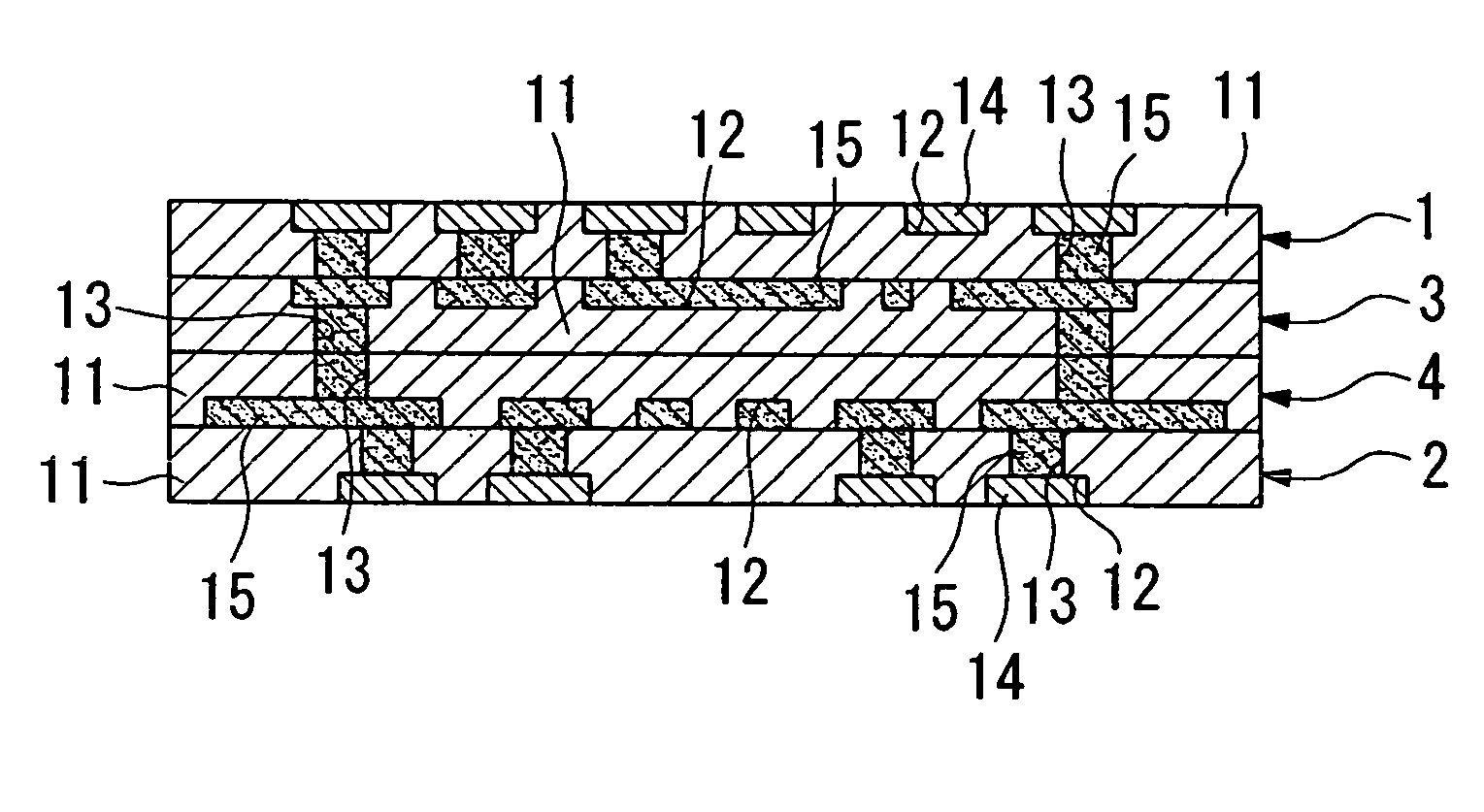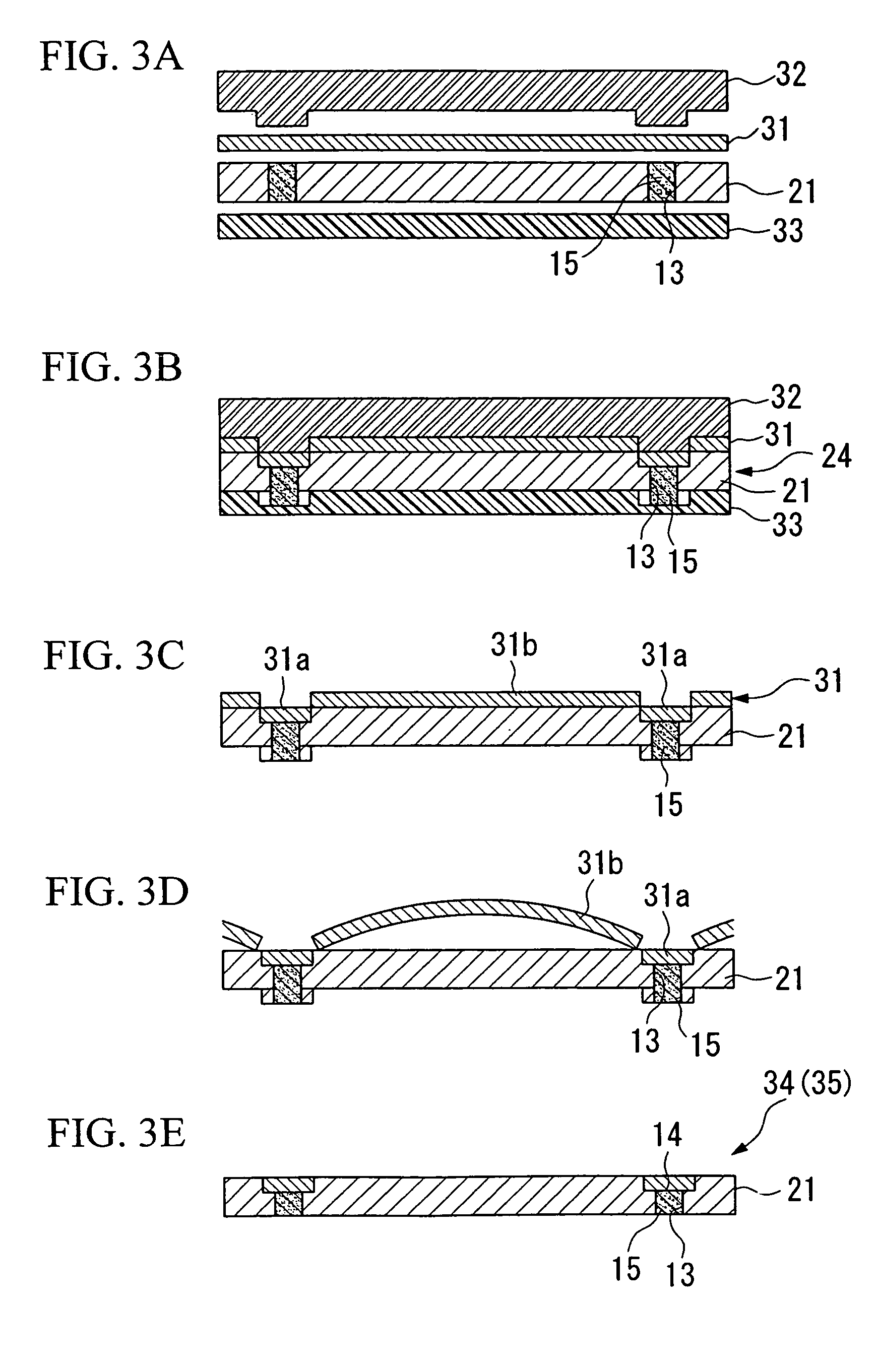Method of manufacturing multilayer wiring board
a manufacturing method and wiring technology, applied in the direction of metallic pattern materials, solid-state devices, thermoplastic polymer dielectrics, etc., can solve the problems of large reduction in the modulus of elasticity, distortion of the conducting material which forms the wiring circuit, and the tendency of the production facility to increase in size, so as to achieve finely detailed conductive wiring and high degree of precision. , the effect of high degr
- Summary
- Abstract
- Description
- Claims
- Application Information
AI Technical Summary
Benefits of technology
Problems solved by technology
Method used
Image
Examples
first embodiment
[0046]FIG. 1 is a cross-sectional diagram showing a multilayer wiring board according to a first embodiment of the present invention. In the figure, symbol 1 represents an uppermost layer substrate (a wiring substrate of the uppermost layer), symbol 2 represents a lowest layer substrate (a wiring substrate of the lowest layer), and symbols 3 and 4 represent inner layer substrates (wiring substrates) sandwiched between the uppermost layer substrate 1 and the lowest layer substrate 4.
[0047]The uppermost layer substrate 1 is typically a film, a thin plate or a sheet of a thickness of no more than 100 μm, wherein grooves 12 for forming a wiring circuit are formed in one surface (the upper surface in the figure) of an insulating substrate 11 formed from a film, a thin plate or a sheet of a thermoplastic resin composition comprising a polyarylketone resin with a crystalline melting peak temperature of at least 260° C. and an amorphous polyetherimide resin as the primary constituents, via ...
second embodiment
[0096]FIG. 7 is a cross-sectional diagram showing an IC package board (a semiconductor device mounting board) of a second embodiment of the present invention.
[0097]This IC package board is a multilayer interposer board 61 comprising a lowest layer substrate 35, an inner layer substrate 49 and an inner layer substrate 50 laminated together in this sequence and integrated into a single unit by thermal fusion, and an IC chip (semiconductor device) 63 is fixed directly to the top of the inner layer substrate 50 which functions as an IC chip (semiconductor device) mounting section, so that the pins (terminals) 64 of the IC chip 63 and the conductive circuit 46 are electrically connected, and the IC chip 63 is then sealed with a sealing resin 65 such as an epoxy resin.
[0098]In order to manufacture this IC package board, first, as shown in FIG. 8A, a cushion film 52 with good elasticity and releasability, a lowest layer substrate 35, an inner layer substrate 49, an inner layer substrate 50...
third embodiment
[0104]FIG. 9 is a cross-sectional diagram showing an IC package board (a semiconductor device mounting board) of a third embodiment of the present invention.
[0105]This IC package board differs from the IC package board of the second embodiment in that whereas in the IC package board of the second embodiment, the IC chip 63 was fixed directly onto the inner layer substrate 50 which functions as the IC chip mounting section, in the IC package board of this embodiment, the IC chip 63 is fixed to the top of the inner layer substrate 50, which functions as the IC chip mounting section, via an IC chip fixing adhesive 62.
[0106]In order to manufacture this IC package board, a multilayer interposer board 61 is first prepared in the same manner as described for the IC package board of the second embodiment, and then, as shown in FIG. 10A, the IC chip fixing adhesive 62 is applied to the top of the inner layer substrate 50 which functions as the IC chip mounting section, an IC chip 63 is mount...
PUM
| Property | Measurement | Unit |
|---|---|---|
| glass transition temperature | aaaaa | aaaaa |
| melting peak temperature | aaaaa | aaaaa |
| crystalline melting peak temperature | aaaaa | aaaaa |
Abstract
Description
Claims
Application Information
 Login to View More
Login to View More - R&D
- Intellectual Property
- Life Sciences
- Materials
- Tech Scout
- Unparalleled Data Quality
- Higher Quality Content
- 60% Fewer Hallucinations
Browse by: Latest US Patents, China's latest patents, Technical Efficacy Thesaurus, Application Domain, Technology Topic, Popular Technical Reports.
© 2025 PatSnap. All rights reserved.Legal|Privacy policy|Modern Slavery Act Transparency Statement|Sitemap|About US| Contact US: help@patsnap.com



